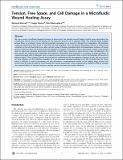Tension, Free Space, and Cell Damage in a Microfluidic Wound Healing Assay
Author(s)
Murrell, Michael; Kamm, Roger Dale; Matsudaira, Paul T.
DownloadMurrell-2011-Tension, Free Space.pdf (1020.Kb)
PUBLISHER_CC
Publisher with Creative Commons License
Creative Commons Attribution
Terms of use
Metadata
Show full item recordAbstract
We use a novel, microfluidics-based technique to deconstruct the classical wound healing scratch assay, decoupling the contribution of free space and cell damage on the migratory dynamics of an epithelial sheet. This method utilizes multiple laminar flows to selectively cleave cells enzymatically, and allows us to present a 'damage free' denudation. We therefore isolate the influence of free space on the onset of sheet migration. First, we observe denudation directly to measure the retraction in the cell sheet that occurs after cell-cell contact is broken, providing direct and quantitative evidence of strong tension within the sheet. We further probe the mechanical integrity of the sheet without denudation, instead using laminar flows to selectively inactivate actomyosin contractility. In both cases, retraction is observed over many cell diameters. We then extend this method and complement the enzymatic denudation with analogies to wounding, including gradients in signals associated with cell damage, such as reactive oxygen species, suspected to play a role in the induction of movement after wounding. These chemical factors are evaluated in combination with the enzymatic cleavage of cells, and are assessed for their influence on the collective migration of a non-abrasively denuded epithelial sheet. We conclude that free space alone is sufficient to induce movement, but this movement is predominantly limited to the leading edge, leaving cells further from the edge less able to move towards the wound. Surprisingly, when coupled with a gradient in ROS to simulate the chemical effects of abrasion however, motility was not restored, but further inhibited.
Date issued
2011-09Department
Massachusetts Institute of Technology. Department of Biology; Massachusetts Institute of Technology. Department of Mechanical Engineering; Massachusetts Institute of Technology. Department of Mechanical Engineering; Whitehead Institute for Biomedical ResearchJournal
PLoS ONE
Publisher
Public Library of Science
Citation
Murrell, Michael, Roger Kamm, and Paul Matsudaira. “Tension, Free Space, and Cell Damage in a Microfluidic Wound Healing Assay.” Ed. Laurent Kreplak. PLoS ONE 6.9 (2011): e24283. Web. 15 Feb. 2012.
Version: Final published version
ISSN
1932-6203